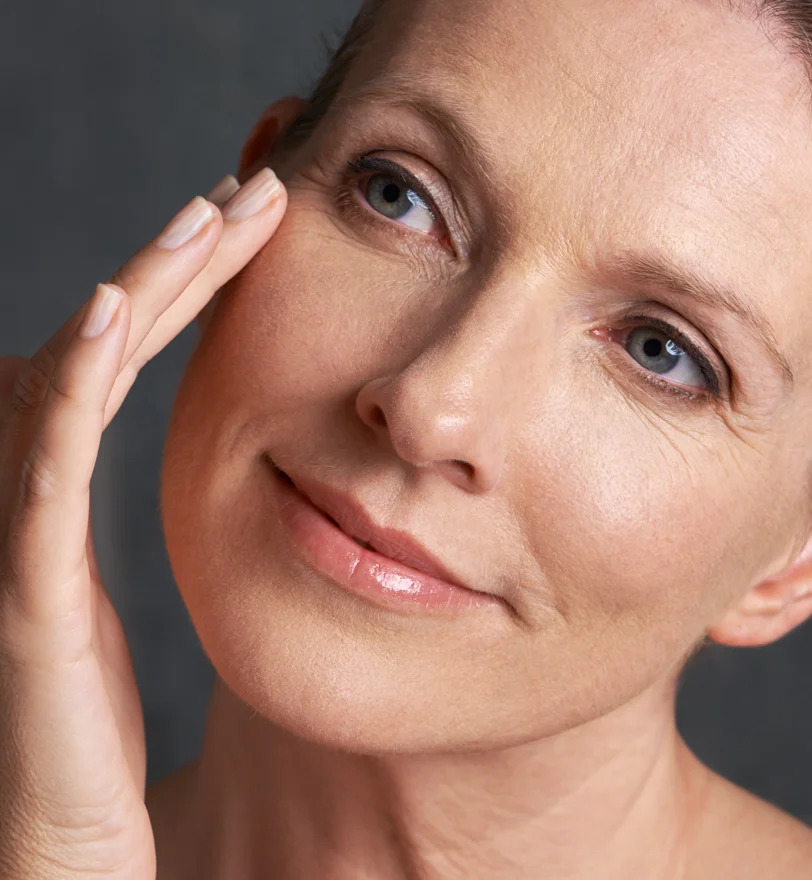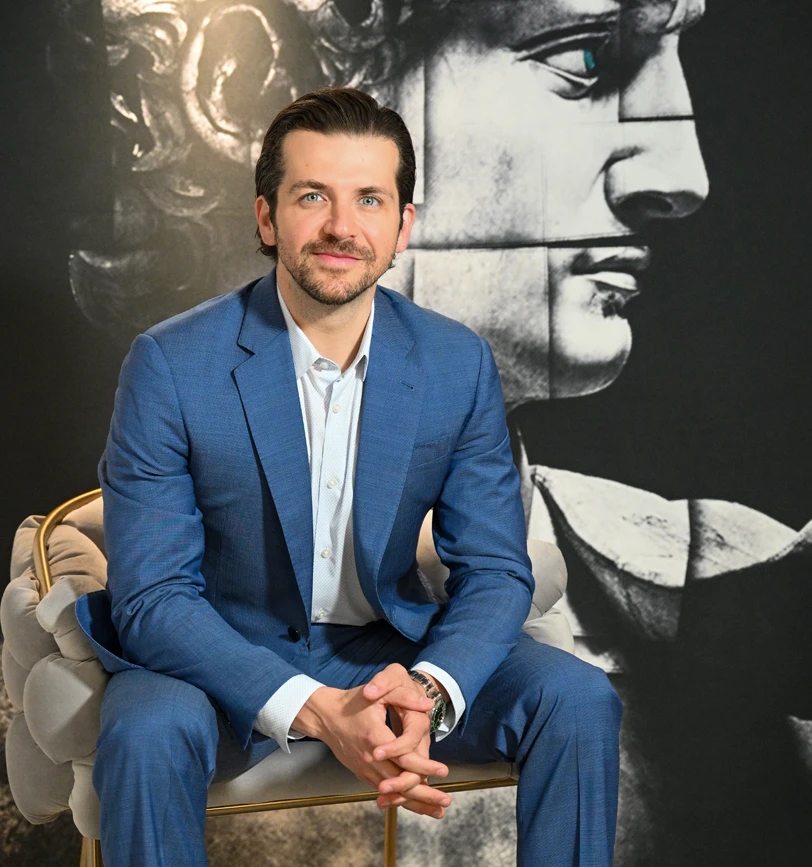
The Deep plane facelift is Dr. Zhuravsky’s preferred choice of facelift for his patients who are looking for the most natural, rejuvenating, and long-lasting results. This approach has become very popular in the world of cosmetic facial plastic surgery for very good reasons, but it has also become somewhat abused by over-marketing and thus has led to some confusion. As an expert facial plastic surgeon, Dr. Zhuravsky not only performs deep plane facelifts in Miami, but he also teaches surgeons from around the world and spends a great deal of time educating patients. This page focuses on helping you as the patient understand the true meaning and concepts behind deep plane facelift surgery.


A deep plane facelift is an advanced technique for performing facelift surgery. The name “Deep plane” refers to the fact that we are lifting the rejuvenating layer of the face (the SMAS) by releasing its deep attachments, rather than simply pulling against them. So the big difference is that we perform surgery one layer deeper in order to avoid some of the classic issues that are seen with other methods. There are several key advantages to this approach that are described in the sections below, but the overall theme is that it allows us to move the facial structures freely, restoring them back to a more youthful position without pulling, tension, or distortion of facial features. This becomes much more clear once you understand the basic concepts of facelift surgery that are explained below.
Our faces have different layers, like an onion, or a bed with different layers of sheets. For simplicity, imagine that the face has just 3 layers; the skin, the SMAS, and the muscles of facial expression. The bone can be thought of as the solid foundation that which these layers are built upon.
The skin is the thin outermost layer that we see from the outside. I like to use the analogy of a form-fitting piece of clothing that has enough elasticity to allow movement but is not as tight or strong as a shaping/compression garment.
As it is the covering of the face, the skin’s aesthetic role is to provide a nice smooth surface over the shapes and contours of the face, which are made by the fat, muscle, and bone underneath. It is elastic enough to allow movement, but it is not strong enough to provide long-term shaping support.
Age-Related Changes
The next layer is the SMAS (Superficial MusculoAponeurotic System), which is the most important layer in facelift surgery. This layer is thicker and stronger than the skin, with its main purpose being to provide support and hold the fat pads of the face. These fat pads are what give the face its smooth shapes and contours. To understand how they contribute, just imagine the face of someone extremely skinny who has lost their facial fat and starts to take on the appearance of the skull beneath.
The situation is a little different in the neck, where the SMAS layer continues as a big flat muscle called the platysma. Imagine a large thin steak that is stretched from the jawline down to the collar bones. There are no equivalent fat pads in the neck. The platysma provides the layer of support and contour.
Age-Related Changes
The major changes in the SMAS layer are related to the loss of fat pad volume and laxity of the SMAS itself.
The support of the SMAS loosens and stretches under the persistent pull of gravity and the fat pads drop over time. This is one of the main things that we witness and try to undo with a facelift. When we use our fingers to pull up on the face, we are using the skin to move those fat pads back up to their more youthful positions. When the fat pads drop, they take away from areas of youth and create fullness in areas that we do not want, like the jowls and nasolabial folds.
In addition to dropping, the fat pads also shrink, which further contributes to the drop. To understand this, imagine someone in a muscle suit. If we deflate the muscles, the suit will fall and become lax from the lack of volume support.
In the neck, we do not have contouring fat pads, only the platysma muscle. Over time, the platysma also becomes loose and begins to hang down from the pull of gravity. The classic vertical bands of the neck (platysmal bands) are the middle edges of each platysma muscle, which become visible over time.
Thus the SMAS and platysma layers are the main targets of facelift surgery, as they are the main structures that fall with age and those that we need to elevate to achieve rejuvenation.
The final layer is made mostly from the muscles of facial expression, which allow us to move our faces. Think of these muscles as little pulleys, or ropes that shorten. At one end they attach to the bone, and at the other, they attach to the SMAS and skin, near important areas of facial movement. So when they contract, they pull on areas like the mouth and nose in order to create facial movement.
The muscles also contribute to some of the shapes and contours of the face but not as significantly as the facial fat pads and SMAS. A more notable example is the masseter muscle, which creates fullness over the angles of the jawline.
Age-Related Changes
The facial muscles also lose volume and become more lax with age, but to a lesser degree than the facial fat pads. Muscle laxity is most notable around the eyes, mouth, and neck as these are more superficial and have less support from underlying bone. However, laxity of the other facial muscles is not a major contributor for the classic signs of aging that we witness, which is why we later explain that it’s NOT exactly the muscles that we are pulling in a facelift.
The facial bones are something that we have all seen at some point as the human skull or the face of a skeleton. This is the foundation of our facial structure and provides support for all the muscles, fat pads, and skin that cover it.
Age-Related Changes
Just like the other layers, the bones decrease in volume, which leads to changes in facial shape and loss of support for the other layers. The classic areas are usually around the eyes, mouth, and jawline.
Now that you understand the basic structures of the face and how they age, let’s put it all together. There are 3 major categories of changes and they all intertwine.
So the SMAS starts to sag and the skin is not strong enough to support it, especially as it ages and loses even more strength and elasticity. Decreases in volume from all layers lead to deflation, which makes the sagging of the SMAS even worse, and leads to further worsening of the skin changes that we see on the surface.
These changes happen to different degrees in each individual, but they all play an important role. We have to recognize the extent of these changes on each individual patient in order to understand what benefits they will get from a facelift.


When most people think of facelifts, they usually imagine pulling on the skin to lift the face and neck. Holding the skin in this desired position can certainly create a nice rejuvenated appearance for a short moment, but it’s not durable and not so simple to achieve surgically. What we are really doing when we mimic a facelift with our fingers is using the skin to pull on the SMAS layer below, as well as to stretch the skin tight enough to make it appear smooth. If this was done surgically, it would not only fail but would also lead to problems and deformities. Skin does not have the adequate strength to maintain this amount of tension for a prolonged period of time.
So if it’s not pulling the skin, then how is a facelift supposed to create the same effect? The magic layer for facelift surgery is the SMAS. The purpose of a facelift is to treat the laxity (as discussed above) that we see by lifting the SMAS, along with its fat pads back up to its youthful position. When the SMAS is elevated, it will also provide better support for the skin above it, allowing us to cut away extra skin without pulling on it directly. Repositioning the fat pads does not only remove fullness from areas where we do not want it (jowls, nasolabial folds), but it also brings them back up to areas where volume has been lost.
The way that the SMAS is elevated is the difference between the types of facelifts which is discussed in more detail elsewhere on this page.


It is important to understand what a facelift cannot treat in order to avoid poor results from overcompensating and false expectations.
A facelift moves fat pad volume back to its youthful location, but it cannot ADD volume that has been lost. It is important for patients to understand which issues are due to volume loss, as these will not be corrected with a facelift alone. A classic example is the pre-jowl, which is located just in front of the jowls. This region is subject to significant volume loss, and can create the appearance of residual jowls after surgery due to the relative hollowing it creates. So it may not be the fullness of a sagging jowl, but the hollowing in front of it that leads to a residual jowl appearance in some cases. Pulling on the jowl with such excessive force to treat a scenario like this would lead to deformities, including distortion of the corners of the mouth.
A facelift involves tightening the skin by supporting it with the SMAS as well as removing the excess skin that would otherwise hang. However, it cannot change the quality of the skin itself. It cannot add back to the thickness or elasticity of the skin that gives it a softer appearance and allows it to snap back like a rubber band. A facelift does not pull the skin so tight that all the wrinkles are erased. If the skin was pulled this tight, it would not allow for free movement of the face or neck and would eventually pull on the areas of attachment, leading to problems like wide scars and pixie ears.
As mentioned, the foundation for a facelift is the lifting of the SMAS layer. The way this is accomplished is the big difference between the types of facelifts. The standard SMAS lift refers to a surgery that peels away the skin from the SMAS, and then uses a variety of methods to pull the SMAS back up to a more youthful position. The problem with this method is that the SMAS is still attached to the layers below it, which leads to resistance and distortion. The deep plane facelift approach solves this problem by going underneath the SMAS and separating those attachments.
When we start a deep plane facelift, we peel back some of the skin, but to a lesser extent than the SMAS lift. Instead of continuing to lift skin, we dive underneath the SMAS layer and separate it from the muscles below. This plane or level of separation is called the deep plane. This is continued down into the neck, underneath the platysma muscle.
Once the SMAS and platysma are free, they are freely mobile and can easily be moved up to their youthful positions without excessive pulling or distortion. This layer also provides support for the overlying skin of the face, which is also elevated along with the attached SMAS. Stitches are used to hold the SMAS in the desired position and the extra skin is trimmed away.
So overall by working deeper, we are able to separate the attachments that are holding us back, as well as to provide a better layer of support for the skin.

When performed at our Miami practice, a deep plane facelift can be done under general, twilight, or local anesthesia depending on the patient. In all cases, the surgery itself is performed the same way. Injections are used to numb the areas (even under general) as they decrease the need for medications and shrink blood vessels to reduce bleeding. The standard facelift incision is used, which traces the hairline of the sideburn, travels in the crease just in front of the ear (and behind the tragus), swings back up behind the ear, and descends along the hairline. The extent and subtleties in design vary between patients depending on their anatomy.
The skin is then peeled away for a short distance. The deep plane is entered and the SMAS is separated from the layers below, freeing it fully. The new mobile SMAS is then easily placed up to its youthful location. Stitches are used to hold it in place, where it will heal and attach. The skin is laid back down as a tailor would lay down a garment. The extra skin is trimmed systematically to avoid taking too much and creating a beautiful tension-free closure. The edges of the skin are stitched and the procedure is complete.
The central neck is often incorporated as well, usually at the beginning of the facelift. An incision is made under the chin to lift the skin and platysmal of the neck. Excess fat is removed from underneath the platysma to improve the “double chin” area, and the muscle is tightened with stitches. The muscle may also be tightened to the hyoid bone of the neck to further improve the neckline. Optional removal or reduction of digastric muscles and submandibular glands may be used by some surgeons to reduce the fullness that these structures can sometimes create in the neck. The risk and benefit ratio of this should be discussed with your surgeon.
The word “minimal” can refer to a few different things in facelift surgery, which makes it confusing. Often it refers to a minimal amount of work and skin elevation, which can lead to problems. Sometimes, we use “minimal” to refer to the length of the incision, in which case it is technically better to call it “minimal access”.
Only select patients are candidates for this, but a minimal access deep plane facelift is possible. Those that do not have a lot of excess skin, may not need the full length of the incision. In these cases, we use a shorter incision, perhaps not extending down the back hairline or around the sideburn. We can still gain access to the deep plane, separate it, and move the SMAS. However, we cannot remove excess skin in the areas that do not have an incision.
The temporal lift is a version of a minimal access approach to the deep plane. Here, we make an incision just inside the hairline over the temple area (similar to a brow lift incision). We enter the deep plane all the way up in this region and continue it down into the face. The deep plane is then lifted up toward the temple area, improving the positioning of the midface facial fat pads, without removing any extra skin.
Recovery after a deep plane facelift from our Miami practice is similar to that of a standard SMAS facelift. The use of facial compression, drains, or a hemostatic net are options that are based on the patient and surgeon’s preference. The following describes the typical recovery of Dr. Zhuravsky’s deep plane facelift patients in Miami.
IMMEDIATELY AFTER: After surgery, a compression bandage is placed around the head to help mitigate swelling. Awake patients are usually ready to go home as soon as 30 minutes after surgery, while anesthesia patients will be groggy and require some time. In both cases, there is not much pain immediately after surgery as the numbing medication is still in effect. This tends to wear off in a few hours as sensation starts to return and patients feel a sense of tightness. This progresses to moderate pain, particularly in the central neck and around the ears. These areas tend to be more sensitive and they are also anchoring points for the platysmal suspension. Entering the deep plane does not add pain to the recovery, and these are points of pain even in smaller lifts. We encourage patients to use the provided pain medications to help lessen the pain / discomfort.
The compression bandages cover the majority of the swelling, but some can be seen around the sides of the neck immediately after surgery. There is also swelling of the central face, but to a lesser degree than typically seen with SMAS lifts. This is because the work here is done deeper, and so the SMAS itself helps compress some of the swelling in the central areas of the face.
There may also be some muscle weakness around the mouth and eye area from the numbing medication, which resolves by evening time.
Patients are instructed to relax in an elevated position (30 degrees or more), avoid any type of bending or lifting, and take their medication the first evening. Cold compresses can be applied to the visible areas if possible.
DAYS 1 – 7: All patients are seen the day after surgery when the compression bandages are removed by Dr. Zhuravsky. At this point, there is a high moderate amount of swelling, which can even give an over-pulled appearance. The incisions are cleaned and checked. All patients are given thorough instructions on after-care and are taught how to complete them. A new elastic compression bandage with velcro is applied and patients are taught how to replace this twice a day.
For the remainder of the week, patients remove the compression dressing to clean their incisions and apply antibiotic ointment twice a day. They are allowed to shower after 48 hours and can wash their hair after 3 – 4 days with a light shampoo. Incisions should be cleansed after showering, as tap water contains bacteria.
The swelling starts to subside around day 3 and improves every day. Patients should still avoid any bending, lifting, or straining. Sleeping should be in the elevated position with either a wedge pillow, specialty mattress, or recliner. Airplane pillows and soft cervical collars are encouraged to avoid unwanted movement during sleep.
AFTER 1 WEEK: Patients return to the office after 1 week for suture removal. The incisions are checked as the stitches are removed. On occasion, a few stitches may be left for another week depending on the healing. For out-of-town patients who leave on day 10, absorbable (dissolvable) sutures are used in these key areas and will fall off on their own. The incisions themselves typically appear as fine lines but may have a few crusts and debris. After suture removal, some incisions may even become a little red and irritated. These areas are usually hidden around the hairline.
At this point, there is still mild to moderate swelling, but with their hair down, most patients can go out in public without drawing unwanted attention. If there was any bruising, it is usually resolved at this point, or faded to a faint yellow tinge.
Swelling improves significantly every few days. Occasional subtle irregularities in contour may be seen toward the outside of the face around week 3. This is due to the difference in swelling resolution over the deep plane segment and skin elevation areas, as well as the deep plane flap itself. These are easy to cover up and resolve in a couple of weeks. Otherwise, most patients are very happy and appear refreshed even as early as 3 weeks after surgery.
It is important to note that the facelift is still being held by stitches underneath the skin at this point. It takes approximately 6 weeks for the layers to heal enough to have somewhat of a decent hold. Therefore, extremes in range of motion and sports that require quick head movements should be avoided for approximately 6 – 8 weeks.
When planning around big events like weddings, galas, or other red carpet festivities we advise at least 6 weeks as a safety cushion to allow for the majority of swelling to resolve and minor irregularities to iron out.
It is always wonderful when surgery goes perfectly according to plan and the anatomy obeys just as intended. However, this is not always the case and is becoming less common due to the many minimally invasive procedures that patients have before they commit to a facelift.
It should be noted that even though we will discuss things that can complicate facelift results, it does not mean that they will prevent you from having great results. Dr. Zhuravsky has performed many successful facelifts with beautiful outcomes on patients with all of these factors, but he has had to take extra caution and effort to do it.
Threads have been a popular procedure for those who want to put off a facelift. The results have been mixed, with some patients liking the results, and others not noticing much improvement. We see patients who have tried them once and others who have used them many times in the past. Threads from the US are dissolvable but they leave behind a trail of collagen and fibrosis. These are sometimes placed deeper than the injector intended, resulting in trails of fibrosis through the deep plane, which can be disorienting in cases of multiple threads. Permanent threads are a bigger issue. Some of these are made from a smooth thread, which can be removed by cutting the knot and pulling it out, but others may have little hooks like barbed wire. Dr. Zhuravsky has seen some significant issues with these permanent “barbed” threads, especially when placed in the wrong layers.
Filler has been one of the most popular minimally invasive procedures for rejuvenation. Reasonable amounts of the correct filler, placed into the correct locations can be beneficial, but large amounts placed inappropriately to treat laxity with volume over-inflation can be a problem. When the face is over-inflated, it can distort the features and make it hard to assess the true nature of the laxity. Additionally, the excess filler can retain water and lead to greater swelling after surgery. Biostimulatory fillers can lead to increased collagen between layers, making them harder to separate.
Radiofrequency, ultrasound, and other energy-based devices are often used to tighten the skin. When used over aggressively they can melt the good fat under the skin, creating hard-to-separate layers and excessively thin crepe skin. These devices do have some good uses and can provide patients some improvement when used properly and conservatively.
There are a few takeaway lessons from these issues. First, it’s important to choose your providers carefully for these minimal procedures in order to make sure your results are going to be “worth it” and done properly. You don’t want to be “sold” on something that you really don’t need and can potentially interfere with the proper surgery. Secondly, avoid doing minimal procedures if you really need a surgical procedure to get the job done properly. Third, maintain a list or log of procedures that you have had in the past and disclose them to your surgeon. This will help them anticipate what they might find during surgery.


Whether it’s Miami, other areas of South Florida, or anywhere else in the world, the goals for choosing your surgeon should be the same. You want a surgeon who is highly trained in the particular surgery, performs it regularly in their practice with great results, and cares for the well-being of their patients. Training and education can be hard to assess, but a board-certified facial plastic surgeon or regular plastic surgeon is a good starting point. Not all surgeons learned deep plane face lifting in their training as the newer techniques have only been popularized over the last 10 – 20 years, and have continued to evolve. Dr. Zhuravsky was very proud to be a faculty member for a course that taught other accomplished surgeons how to perform this technique. Those surgeons went on to expand their practice and expertise with great success. A surgeon’s willingness to continue to improve by learning from others, attending conferences, reading journals, and reflecting back on their own work is very important. The way you get good at these types of surgeries is by learning everything there is to know, then putting it to practice safely, improving with every case. You have to be able to trust your surgeon and feel that they will do everything in their power to give you the best results with the greatest safety.
Dr. Zhuravsky is a board-certified facial plastic surgeon, who performs high-quality deep plane facelifts on a regular basis. He treats all his patients the same way he would want any of his own family members treated. Therefore, he always makes sure to be updated on the latest techniques and perform each surgery with a level of precision and care that will provide the best results in the safest way possible. Dr. Zhuravsky feels that it is a great honor and privilege when patients trust him with their faces and he takes this responsibility very seriously. The goal is to have every patient go into surgery with confidence that they are in great hands, and then to feel the joy and excitement after they see the results.
Our patients are not only from Miami, Boca Raton, and the surrounding areas of South Florida, but they also travel from distant states for Dr. Zhuravsky’s expertise and care. Local patients are encouraged to come in person, while those from greater distances can schedule a virtual consultation.
